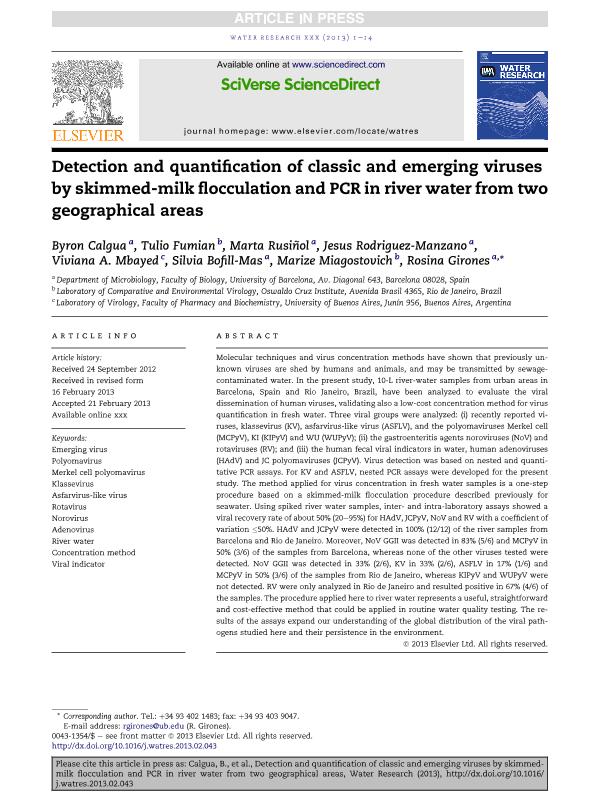Artículo
Detection and quantification of classic and emerging viruses by skimmed-milk flocculation and PCR in river water from two geographical areas
Calgua, B.; Fumian, T.; Rusinol, M.; Rodríguez Manzano, J.; Mbayed, Viviana Andrea ; Bofill Mas, S.; Miagostovich, M.; Girones, R.
; Bofill Mas, S.; Miagostovich, M.; Girones, R.
 ; Bofill Mas, S.; Miagostovich, M.; Girones, R.
; Bofill Mas, S.; Miagostovich, M.; Girones, R.
Fecha de publicación:
15/03/2013
Editorial:
Elsevier
Revista:
Water Research
ISSN:
0043-1354
Idioma:
Inglés
Tipo de recurso:
Artículo publicado
Clasificación temática:
Resumen
Molecular techniques and virus concentration methods have shown that previously unknown viruses are shed by humans and animals, and may be transmitted by sewage-contaminated water. In the present study, river water from urban areas in Barcelona, Spain and Rio de Janeiro, Brazil, were analyzed to evaluate the dissemination of human viruses, while simultaneously optimizing and validating a low-cost concentration method for virus quantification in fresh water. The following three viral groups were analyzed. (i) Recently described viruses: klassevirus (KV), asfarvirus-like virus (ASFLV), and the polyomaviruses Merkel cell, KI and WU (MCPyV/KIPyV/WUPyV). (ii) Gastroenteritis agents: noroviruses (NoV) and rotaviruses (RV). (iii) Human fecal viral indicators in water: human adenoviruses (HAdV) and JC polyomaviruses (JCPyV). Virus detection was based on nested and quantitative PCR assays. Nested PCR assays were developed for KV and ASFLV. The method applied for virus concentration in water samples was a one-step procedure based on a skimmed milk flocculation procedure described previously for seawater. Using spiked river water samples, inter- and intra-laboratory assays showed a viral recovery rate of about 50% for HAdV, JCPyV, NoV and RV with a coefficient of variation ≤ 50%. HAdV and JCPyV were detected in 100% of the river samples from Barcelona and Rio de Janeiro. Moreover, NoV GGII was detected in 100% and MCPyV in 50% of the samples from Barcelona, whereas none of the other viruses analyzed were detected. NoV GGII was detected in 33%, KV in 33%, ASFLV in 17% and MCPyV in 50% of the samples from Rio de Janeiro, whereas KIPyV and WUPyV were not detected. RV were only tested for in Rio de Janeiro and resulted positive in 67% of the samples. The procedure applied here to river water represents a useful, straightforward and cost-effective method that could be applied in routine water quality testing. The results of the assays expand our understanding of the global distribution of the viral pathogens studied here and their persistence in the environment.
Archivos asociados
Licencia
Identificadores
Colecciones
Articulos(OCA HOUSSAY)
Articulos de OFICINA DE COORDINACION ADMINISTRATIVA HOUSSAY
Articulos de OFICINA DE COORDINACION ADMINISTRATIVA HOUSSAY
Citación
Calgua, B.; Fumian, T.; Rusinol, M.; Rodríguez Manzano, J.; Mbayed, Viviana Andrea; et al.; Detection and quantification of classic and emerging viruses by skimmed-milk flocculation and PCR in river water from two geographical areas; Elsevier; Water Research; 47; 8; 15-3-2013; 2797-2810
Compartir
Altmétricas



